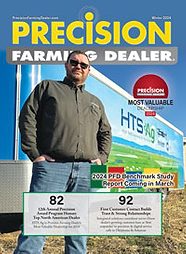Attendees highlight several technologies that are moving from theory to reality.
Jack Zemlicka, Technology Editor
After nearly 180 presentations, the 11th International Conference on Precision Agriculture drew to a close on Wednesday, July 18 in Indianapolis.
The general consensus among attendees — including engineers, ag scholars, economists and researchers from around the world — is that the programs provided a glimpse into the not too distant future for precision farming technology.
As one veteran attendee put it, “Last year, a lot of this stuff was theoretical, but this year, we’re getting closer to making it practical.”
Precision Farming Dealer did an informal survey near the end of the conference to find out what some attendees found to be the most interesting topics in precision ag discussed during the three-day event.
 Tom Mueller, presenter at the International Conference on Precision Agriculture, shares that farmers can get "more bang for their buck" when they can electronically predict erosion in the field. |
Here are the top five topics mentioned:
-
Remote Sensing: Several attendees say the technology behind making remote sensing for things like crop disease detection and nitrogen application is closer than ever. As one scholar says, “the academic technology in that area, like on-the-go sensors, is getting closer to being a commercial fit.”
-
Data Management: The ability to take information produced by precision farming technology and put it to use is still something that plagues the industry. Sessions dealing with aggregating and transferring precision data were well attended. One presenter on the topic says, “Without the retailer, without the local equipment companies, this won’t work because there’s got to be some local intelligence and local knowledge.”
-
Fluorescence Sensing: Several attendees said the experimentation being done with fluorescence sensing in corn is rapidly developing beyond theoretical application. As one engineer says, “We are just now learning about how this can help detect nitrogen deficiencies at an earlier stage.”
-
Robotics and Automation: Although still a ways off, this technology sparked interest among attendees. As one scholar says, “This could change the way fields are farmed and the size of equipment that is used in the future.”
-
Soil Testing: A number of attendees said there is a growing emphasis on getting more out of soil sampling and being able to generate useful data from tests. While one scholar says soil testing hasn’t changed much since the 1940s, the ability to calibrate tests using sensors and the availability of computers to process the results, are updating traditional testing methods.






Post a comment
Report Abusive Comment